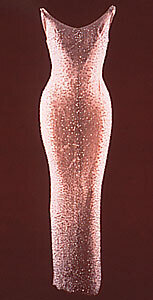Why does this 1950s dress cost $49, this one $98 and that one $300? Ever wondered why the big differences?

I am sometimes asked if I can accept an offer of a lower price for an item I have for sale, and I don’t like to just bluntly refuse without an explanation. Sometimes I’m asked how to price a vintage item, or why an item I’m selling is a certain price. This post is to explain a little about the vintage clothing and accessories marketplace and the pricing one sees.
First, you need to know how vintage clothing is acquired by those who present it for resale. With the exception of some one-shot eBay sellers, it is infrequently something from the seller’s own closet or family’s closets. Very infrequently it was given to the seller. Usually, vintage sellers who have been around any length of time must find and purchase vintage fashions. They may get up very early to get in line for promising estate sales, garage sales, car boot sales and flea markets. They may put ads out for purchasing vintage clothing and go on buying trips to nearby (or far away) cities and towns. They may regularly scour the thrift, second-hand and antique markets. Auctions can also be sources. The seller has to make many good contacts, persevere and be resourceful.
What impacts a price



1920s beaded and embroidered silk chiffon dress auctioned by Augusta Auctions in 2016. The price realized was $1,140
Some other scarcity issues involve sizes (such as larger shoe and dress sizes) and types of items (generally trousers are more worn out and disposed of than skirts, menswear more than womenswear, swimsuits can take a beating, as can shoes… ).



Pierre Balmain adjusting a dress on model Ruth Ford in 1947 (photographed by Carl Van Vechten)




The famous Jean Louis gown worn by Marilyn Monroe in 1962




Do all these add up to a formula for how much that 1950s dress should cost? No, not at all. Pricing changes every day and it is nebulous. Even the best sellers make mistakes in pricing, and the least experienced seller may earn top money on a particular item. Desirability may make an item of low quality into the coolest and most valuable thing in the shop for some people. The best shop owner may have prices so low that you wonder if the item is of any quality. There are simply no hard and fast rules about pricing.
Then there is the thrift shop purchase. You know, the one where you found a designer dress from the 1950s in top condition and half off of $7.50? Almost everyone who has ever loved the thrill of the hunt has a story to tell of some incredible deal. This has the effect of making the general public think that all one needs is a bit of pocket change and a trip to the thrift. Of course finding something great and vintage for next to nothing is rare and getting rarer, so if you fancy items that predate the 1980s, you will mostly come up empty.
There may also be the perception that a vintage seller doesn’t do anything but buy, mark up the price and resell. Some might do no more than that, but those who take the business seriously do lots more. For instance, I do a lot of research and stay in close touch with colleagues here at the Vintage Fashion Guild who can help me when I don’t know something about a vintage piece. I have a couple of bookshelves full of vintage fashion history books. I did so much research on fabric that I ended up volunteering to write and compile the VFG’s Fabric Resource. Over the course of years I’ve built up many contacts and quite a lot of knowledge.
In my house there are always buckets of vintage items soaking, needles with every color of thread stuck in a pincushion, bags of metal zippers, jars of vintage buttons. I have a very careful dry cleaner that I trust and an expert seamstress for things I can’t fix myself. I have a storage cabinet full of various stain removers, gentle washes and odor lifters. Not only do I read and write blogs about vintage fashion, I participate in the conversations about it on Facebook, Twitter, Instagram and Pinterest. In my selling practices I am as careful and honest as I can be. I am passionate about what I do. I sincerely care about each individual who crosses my vintage path. And I am not alone in any of this—there are quite a few really excellent vintage fashion shops (many run by VFG seller-members). Is what we do more than buying and reselling? I think so.
Bottom line? There’s no magic formula for pricing vintage, but these are some of the considerations that might be taken into account.
Written by Maggie Wilds/denisebrain